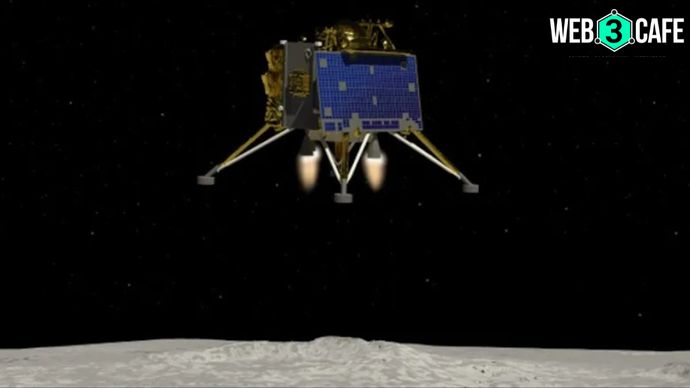Chandrayaan 3 Moon Mission: Here's the tech & AI that will help Vikram lander reach the moon
As Chandrayaan 3 sets its sights on the Moon's South Pole, a trio of advanced components lander, rover, and propulsion module help in a new era of lunar exploration. Here's a look at the tech that is helping make this mission successful

Highlights
- The propulsion module of Chandrayaan-3 features an innovative payload called SHAPE
- The Vikram lander is equipped with a suite of cutting-edge instruments that facilitate comprehensive lunar exploration
- The Pragyan rover employs advanced tools like the APXS and LIBS for detailed elemental analyses of the lunar landing site
In the quest to conquer lunar exploration, India's mission Chandrayaan 3 stands as a testament to cutting-edge technology. With the recent setback of Russia's Luna-25, the world's attention shifts to India's third space mission, aiming to touch down on the Moon's surface on 23 August. If it is successful, this milestone would mark India's entry into the elite league of lunar explorers, alongside the USA, China, and Russia.
Chandrayaan 3's key highlights encompass a propulsion module, a state-of-the-art lander named Vikram, and the intelligent Pragyan rover.
On 17 August, the lander and rover disconnected from the propulsion module and began their descent towards the lunar surface. Meanwhile, the propulsion module will remain in orbit for an extended period, conducting a sequence of experiments over months and even years.
Propulsion module
The heart of Chandrayaan 3's journey, the propulsion module, harbours a groundbreaking payload called Spectropolarimetry of Habitable Planet Earth (SHAPE). As the module orbits the Earth, it conducts experiments that range from analysing Earth's atmosphere through spectroscopic analysis to capturing exoplanet signatures for habitability assessment. Powered by a 440N Liquid Engine and bolstered by a star sensor, TTC antenna, and solar panel, this module plays a pivotal role in Chandrayaan 3's mission.
Vikram lander's high-tech arsenal
The Vikram lander, after parting ways with the propulsion module, ventures towards the lunar surface equipped with a suite of cutting-edge instruments. Among them, the Langmuir Probe (LP) estimates plasma density, while Chandra's Surface Thermophysical Experiment (ChaSTE) and the Instrument for Lunar Seismic Activity (ILSA) measure thermal conductivity, temperature, and seismic activity around the landing area. NASA's passive Laser Retroreflector Array contributes to lunar laser ranging studies.
In order to effectively accomplish its mission goals, the lander is furnished with an array of technological tools, including the Laser Altimeter (LASA), Lander Horizontal Velocity Camera (LHVC), Laser Doppler Velocimeter (LDV), Lander Position Detection Camera (LPDC), Ka-Band Altimeter (KaRA), Lander Hazard Detection and Avoidance Camera (LHDAC), Laser Inertial Referencing and Accelerometer Package (LIRAP), as well as, inclinometer, micro star sensor and touchdown sensors.
Pragyan rover
The Pragyan rover takes lunar analysis to new heights with its Alpha Particle X-Ray Spectrometer (APXS) and Laser Induced Breakdown Spectroscope (LIBS). These sophisticated tools enable the rover to perform qualitative and quantitative elemental analyses of the landing site. Furthering our understanding of the lunar surface, the APXS investigates soil and rocks' elemental compositions. Navigation cameras, Rx/Tx antenna, wheel drive assembly, and solar panels empower the rover to navigate the Moon's terrain.
"We will be closely overseeing and managing the spacecraft's operations from ISTRAC Bengaluru," remarked P Veeramuthuvel, the nervous project director of Chandrayaan 3, on 14 July during its launch from the Satish Dhawan Space Center in Sriharikota, while speaking to Indian Express.
He emphasised that the critical phase for the mission is the "final powered descent" for a soft landing. Mission control in Bengaluru will receive signals from the Chandrayaan 3 lander via ground stations like the Deep Space Network in Bengaluru, the Jet Propulsion Laboratory in the US, and a European Space Agency station in Spain. Alternatively, signals can be relayed through the Chandrayaan 2 orbiter, which established contact recently.
AI to pilot Chandrayaan 3
During the descent phase, starting on August 23 at 17:47 hours for a landing at 18:04 hours, mission control won't be able to send commands to the lander. The lander will rely on its programmed AI for a safe landing.
Sensors are at the heart of Chandrayaan 3, enabling it to sense its position, speed, and orientation. Various sensors, including velocimeters, altimeters, hazard avoidance cameras, and inertia-based cameras, work together through computer algorithms to determine the lander's location accurately. The navigation, guidance, and control system onboard the lander also plays a crucial role, steering it towards the correct landing position.
The configuration is meticulously designed for a safe and gentle landing, addressing past challenges extensively. Simulations, updated guidance designs, and algorithm adjustments ensure accurate performance even in the face of nominal variations. This time, efforts have been made to enable the lander to attempt a vertical landing, enhancing the mission's prospects of success.
With anticipation building and the global community's eyes on the Chandrayaan 3 mission, India's journey to the lunar South Pole promises not only groundbreaking scientific discoveries but also a testament to the nation's prowess in space technology. As the historic touchdown approaches, the world holds its breath in hope and excitement for the achievements that lie ahead.
